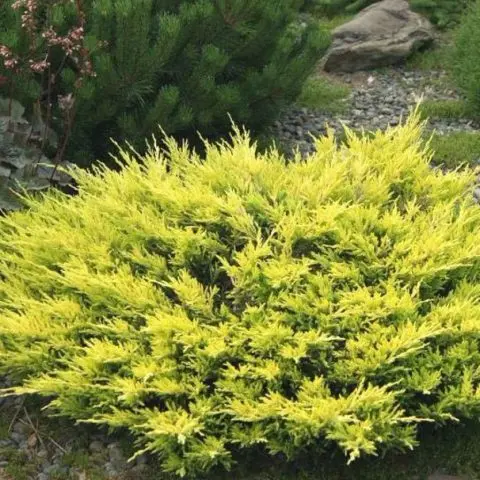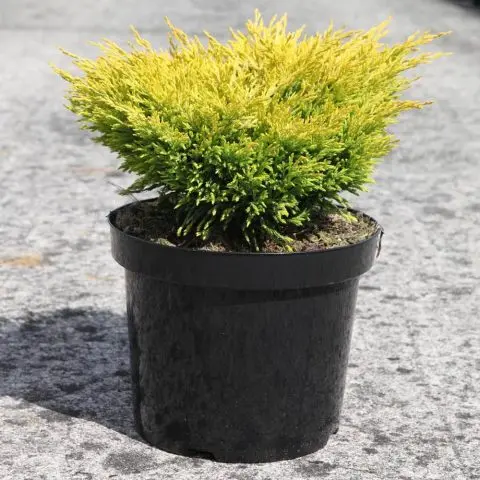Contents
Juniperus horizontalis Laim Glow is an ornamental evergreen shrub. Forms a compact bush with a mixed shade. It is used in various styles, in landscape design, as well as in urban improvement. The shrub is resistant to aggressive environments.
Description of juniper Limeglow
Juniper horizontal Lime Glow (juniperus horizontalis Limeglow) was bred in 1984 by American breeders. The variety is obtained from crossing undersized junipers growing in the wild. The name Lime Glow – lemon radiance, the variety received for the original color.

Description and photos of Lime Glow juniper show that needles that receive enough light have a light yellow color. In autumn, it turns into a reddish hue. In winter, as well as junipers growing in the shade, the color changes to green.
High frost resistance and drought resistance make it possible to grow shrubs in regions with different climates. Thanks to the changing shades, the bush looks decorative all year round, including on a low snow cover.
The plant is slow growing. The annual growth of Lime Glow horizontal juniper is from 7 to 10 cm. At the same time, it can grow in one place for several centuries. Refers to dwarf shrubs, its size in height does not exceed 40 cm.
An adult bush develops symmetrically, reaches 1,5-2 m in diameter and forms a funnel shape. The crown is lush, soft. The needles are scaly, small. Stems creeping, skeletal branches branching moderately. In the border landing, reaching the edge of the surface, the stems begin to slide down. At the same time, part of the shoots grow upwards, which forms a voluminous, neat bush.
Juniper Lime Glow in landscape design
Under natural conditions, juniper grows along the banks of rivers, is found in the mountains. This feature of the plant is used to decorate decorative ponds in the garden, as well as the lower rows of rock gardens.
From the description of the Lime Glow horizontal juniper, it follows that the plant can be used as a ground cover for framing paths or decorating open areas of the site. To create a lemon carpet, 3 bushes are planted per 1 sq. m.
Due to the bright coloring, an ornamental shrub of a horizontal type of growth is successfully used in single plantings. A single planted bush creates an accent in the garden, attracting attention from early spring to late autumn. A photo of the Lime Glow juniper in the garden design shows that the shrub does not need additional framing and, in a single planting, it also looks spectacular without companion plants.
For a joint planting in a flower bed, the lemon shade of juniper is combined with purple, lilac or yellow flowers. An evergreen shrub is combined in one composition with barberry, panicled hydrangea, heather. From undersized crops, hosts are planted next to the horizontal juniper.
Shining shrubs are used to create coniferous corners in combination with other evergreen crops and stones.
Planting and caring for juniper Laim Glow
To plant a horizontal juniper, Laim Glow buys seedlings that are sold with a closed root system. The seedling should look healthy, without reddish and dry shoots, correspond to the description of the variety.

Seedlings with an open root system must be transplanted immediately after purchase. Young plants take root better than adult bushes.
Seedling and planting preparation
It is most favorable to transplant horizontal juniper in early spring, at which time the root system is intensively growing. Spring planting allows the shrub to adapt and take root before the onset of cold weather.
A permanent place for growing is chosen, because an adult plant has a deep root system and does not tolerate transplantation well. When planting, it is also important to take into account the area for future growth and spreading of the bush.
Soils for planting are preferably sandy, with good water permeability. On clay soils, the culture takes root difficult. Suitable soil acidity for growing is slightly acidic or neutral. In order for the plant to acquire a lemon color, it must be grown in a sunny place. It tolerates cultivation in windy areas.
Rules of landing
Planting pits or trenches are dug for planting seedlings. The soil is taken out immediately before planting. The recess is made several times larger than the earthen coma in which the seedling was located before transplantation. But the bottom of the landing pit is covered with a drainage layer of 20 cm. The pit is spilled with water before planting.
For planting, use a soil mixture consisting of:
- 2 parts of peat;
- 2 pieces of loose earth;
- 1 pieces of sand.
The root system is doused with growth stimulants before planting. The depth of planting is observed the same at which the plant grew earlier, without deepening. The roots in the planting hole are straightened. Then the seedling is covered with the prepared substrate and lightly pressed. After planting around the perimeter of the crown, an earthen roller is made and a bucket of water is poured under the plant. The soil is mulched with peat or coniferous litter.
To prevent fungal diseases after transplantation, the plant is sprayed with disinfectants. In spring, the young plant is covered from bright sunlight.
Watering and top dressing
Juniperus horizontalis Lime Glow is a drought-resistant plant. An adult bush is watered several times a season, especially during periods of prolonged hot weather. The shrub needs air humidification, so the best way to water it is sprinkling.
In the year of transplantation, until the plant has grown stronger, it needs more frequent watering. During this period, the soil should not be allowed to dry out. To increase the humidity of the air, the shrub is sprayed manually from a spray bottle.
In the spring, nitroammophoska is applied 1 time under a bush. Fertilizers are distributed according to the diameter of the near-stem circle, covered with soil and be sure to water. Organics such as manure or chicken manure are not used because of its adverse effect on the roots of the shrub.
Mulching and loosening
Dwarf juniper is grown on loose soils, on which weeds should not be present. Loosening is carried out superficially.

Mulching for horizontal juniper Laim Glow is used not only as an agricultural technique, but also for decorative purposes. Mulching with tree bark or chips, as well as pine cones, prevents moisture loss and frees you from constant weeding and loosening. Pebbles or gravel are used only on loose soil.
Trimming and shaping
The crown of the horizontal juniper is formed symmetrically, with a recess in the middle, characteristic of the variety. The shrub does not need pruning. Formation weakens the plant, becomes the cause of diseases. Only dried or broken shoots are removed from the bush.
Preparation for winter
Frost resistance Lime Glow juniper up to -35°С. Therefore, for the winter, the shrub can be left without shelter. But young plants, up to 4 years old, are covered with spruce branches for the winter, the soil under the bush is covered with peat. After wintering, the old mulch is raked, the soil is loosened and a new layer of covering materials is poured.
Reproduction of juniper average Lime Glow
Most often, the cutting method is used to propagate the horizontal juniper Laim Glow. Cuttings are harvested in the spring, cutting them off from an adult plant. Planting material must be lignified.
For germination, the lower part of the cutting is cleaned of needles. Rooting is carried out in a soil mixture composed of equal parts of sand and peat. The stalk is planted in the planting container at an angle.
It is possible to breed by layering, in this case the lower shoot is pressed to the soil and added dropwise. The seed method is more laborious, given the overall slow growth of the crop. When propagated by seeds, the characteristics of the variety may not be fully preserved.
Diseases and pests of the horizontal juniper Limeglow
Juniper horizontalis Laim Glow is resistant to diseases and pests. But when grown in unsuitable conditions (when planted in lowlands, dense soil or near frequently affected crops), it can become infected with fungal diseases. It is also susceptible to attacks by aphids and scale insects. To avoid the occurrence of diseases, preventive spraying is carried out, growing conditions are improved.
Conclusion
Juniperus horizontalis Lime Glow is one of the best plants for landscaping and garden decoration. The evergreen shrub does not require complex care, including due to a small annual increase. Soft needles, original coloring and independent symmetrical formation – thanks to all this, the Limeglow horizontal juniper deserves only positive reviews.









